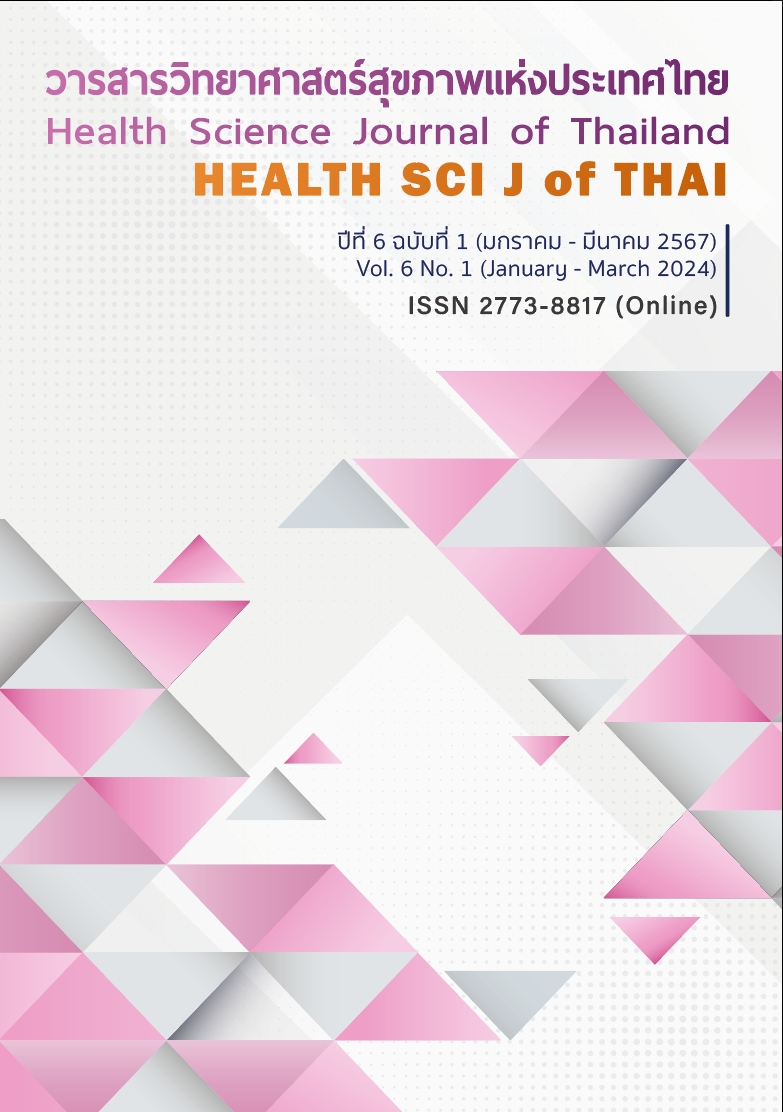Development of Star Excursion Balance Test Kit
Main Article Content
Abstract
The development of star excursion balance test (SEBT) kit is the development of equipment to assess practicing dynamic balance and conducting research as well as in physical fitness training, the prevention and treatment of injuries, and rehabilitation. It is an experimental research model. The researchers designed and built the SEBT kit and then compared the measurement results obtained using the developed kit with the results obtained using a floor-mounted tape-based SEBT, as well as assessing satisfaction of the developed SEBT kit of 60 healthy female and male volunteers aged 18 - 35. The dynamic balance of both legs was tested in 8 directions with both methods. Data were analyzed using descriptive statistics describing general characteristics of the subjects, satisfaction score, and the SEBT test score. Paired Sample t-test was used to compare the results of both assessment methods. The dynamic balance test results showed no statistically significant differences for the left leg and the right leg in all directions between the developed SEBT kit and floor-mounted tape-based (p > 0.05). In conclusion, the developed SEBT kit can be used to test dynamic balance and users are satisfied with the developed SEBT kit at the highest level.
Article Details

This work is licensed under a Creative Commons Attribution-NonCommercial-NoDerivatives 4.0 International License.
References
McMillan IR, Carin-Levy G. Tyldesley & Grieve’s muscles, nerves and movement in human occupation (Fourth edition). Oxford: Wiley Blackwell; 2012.
Kinzey SJ, Armstrong CW. The reliability of the star-excursion test in assessing dynamic balance. J Orthop Sports Phys Ther 1998; 27(5): 356-60.
Hertel J, Miller SJ, Denegar CR. Intratester and intertester reliability during the star excursion balance tests. J Sport Rehabil 2000; 9(2): 104-116.
Miller T. NSCA's Guide to tests and assessments. Champaign: Human Kinetics; 2012.
Chaiwanichsiri D, Lorprayoon E, Noomanoch L. Star excursion balance training: effects on ankle functional stability after ankle sprain. J Med Assoc Thai 2005; 88(Suppl 4): S90-4.
Plisky PJ, Gorman PP, Butler RJ, Kiesel KB, Underwood FB, Elkins B. The reliability of an instrumented device for measuring components of the star excursion balance test. N Am J Sports Phys Ther 2009; 4(2): 92-99.
Pollock KM. The star excursion balance test as a predictor of lower extremity injury in high school football players [dissertation]. [Toledo (OH)]: University of Toledo, College of Health Sciences; 2010.
Gribble PA, Hertel J, Plisky P. Using the star excursion balance test to assess dynamic postural-control deficits and outcomes in lower extremity injury: a literature and systematic review. J Athl Train 2012; 47(3): 339-357.
Movement Assessment Technologies. Movement Assessment ToolTM [Internet]. 2014 [cited 2019 April 11]. Available from: https://www.matassessment.com/store/zRV53t5x
Perform Better. FMS Y-Balance Test Kit [Internet]. - [cited 2019 April 11]. Available from: https://www.performbetter.com/FMS-Y-Balance-Test-Kit
Powden CJ, Dodds TK, Gabriel EH. The reliability of the star excursion balance test and lower quarter Y-balance test in healthy adults: a systematic review. Int J Sports Phys Ther 2019; 14(5): 683-694.
Olmsted LC, Carcia CR, Hertel J, SJ Shultz. Efficacy of the star excursion balance tests in detecting reach deficits in subjects with chronic ankle instability. J Athl Train 2002; 37(4): 501-506.
Uebayashi K, Akasaka K, Tamura A, Otsudo T, Sawada Y, Okubo Y, Hall T. Characteristics of trunk and lower limb alignment at maximum reach during the star excursion balance test in subjects with increased knee valgus during jump landing. PLoS One 2019; 14(1): e0211242.
Toiem K, Phonsrithi C, Boonchuay N, Nacharoen P, Tantarawongsa P, Somthavil S, Boonyarom O, Srisupornkornkool K. Effect of functional balance training on dynamic postural control in those who wear high-heeled shoes. Chula Med J 2018; 62(5): 843-858. (in Thai)
Somthavil S, Boonyarom O, Srisupornkornkool K, Toiem K, Phonsrithi C, Boonchuay N, Nacharoen P, Tantarawongsa P. The effect of functional balance training on the balancing abilities of those who wear high-heeled shoes. Songklanakarin J Sci Technol 2019; 41(6): 1260-1266.
Armstrong R, Brogden CM, Milner D, Norris D, Greig M. The influence of fatigue on star excursion balance test performance in dancers. J Dance Med Sci 2018; 22(3): 142-147.
Bhanot K, Kaur N, Brody LT, Bridges J, Berry DC, Ode JJ. Hip and trunk muscle activity during the star excursion balance test in healthy adults. J Sport Rehabil 2019; 28(7): 682-691
Gkrilias P, Zavvos A, Fousekis K, Billis E, Matzaroglou C, Tsepis E. Dynamic balance asymmetries in pre-season injury-prevention screening in healthy young soccer players using the modified star excursion balance test-a pilot study. J Phys Ther Sci 2018; 30(9): 1141-1144.
Jaber H, Lohman E, Daher N, Bains G, Nagaraj A, Mayekar P, Shanbhag M, Alameri M. Neuromuscular control of ankle and hip during performance of the star excursion balance test in subjects with and without chronic ankle instability. PLoS One 2018; 13(8): e0201479.
López-Plaza D, Juan-Recio C, Barbado D, I Ruiz-Pérez, FJ Vera-Garcia. Reliability of the star excursion balance test and two new similar protocols to measure trunk postural control. PM&R 2018; 10(12): 1344-1352.
Gribble PA, Hertel J. Considerations for normalizing measures of the star excursion balance test. Meas Phys Educ Exerc Sci 2003; 7(2): 89-100.
Lanning CL, Uhl TL, Ingram CL, Mattacola CG, English T, Newsom S. Baseline values of trunk endurance and hip strength in collegiate athletes. J Athl Train 2006; 41(4): 427-434.
Dechakaneewong T. The study on plastwood printmaking. AJNU 2020; 11(2): 224-237. (In Thai)


